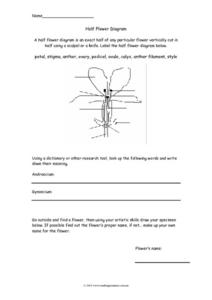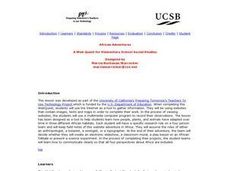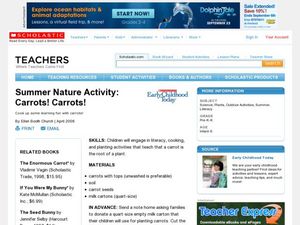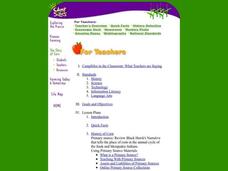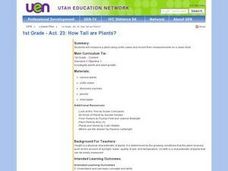Polar Trec
Where is the World's Water?
Scholars discover the amount of the Earth's water in various locations such as the ocean, ice, the atmosphere, etc. They then make a model of the how much water those percentages represent. Finally, analysis questions bring the concepts...
California Academy of Science
Sustainable Water Solutions: Weighing the Pros and Cons
Switching indoor water fixtures to low flow reduces water usage by more than 45 percent. This and other solutions to reduce water usage have both pros and cons. Scholars view videos of different solutions, discuss them in small groups,...
North Carolina Consortium for Middle East Studies
Missing Pieces of the Puzzle: African Americans in Revolutionary Times
What's missing from most studies of the American Revolutionary War is information about the role African Americans played in the conflict. To correct this oversight, middle schoolers research groups like the Black Loyalists and Black...
Curated OER
Half Flower Diagram
In this half flower diagram instructional activity, students label flower parts on a "half flower" diagram, use a dictionary/research tool to write definitions for 2 given words, and draw a picture of a flower they find.
Curated OER
Pollination
In this pollination worksheet, students read and assess comprehension. In this labeling and filling in the blanks worksheet, students answer fourteen questions.
Curated OER
Structures Slide Show
Fourth graders investigate basic plant anatomy. They create an effective slide show showing the plant anatomy and life process of a plant of their choice. Students use PowerPoint to create their presentations.
Curated OER
The Circle of Life
Fourth graders examine how the different organisms living in an ecosystem affect one another. In groups, they research a specific ecosystem and present their findings to the class based on the type of organisms found in it. To end the...
Curated OER
Climate Change
Students focus on the production of maple syrup in Northern New England as they study the effects of climate change. They investigate other environmental factors on the forests of Northern New England.
Curated OER
Blowing and Flowing
Fifth graders compare and evaluate the rate of erosion from water and wind on three type of landscape: bare land, land with sparse vegetation, and land covered by dense vegetation.
Curated OER
Bacteria: Friend or Foe?
Young scholars examine a variety of environmental and industrial roles of bacteria. explore where bacteria can be found and distinguish bacteria from other organisms.
Curated OER
African Adventures
Students access the Internet to gather information. They record their observations of African habitats. They create either an electronic slideshow or mural to present a science experiment.
Curated OER
On The Farm
Young scholars study a dairy farm and also the crops that grow on farms. They research how we depend on farms to get the food we eat. They transform their findings and describe one the farms or make up their own. They turn the...
Curated OER
And Just How DO You Kill A Weed?
Young scholars explain chemical, cultural and biological weed control methods. They design and conduct an experiment to simulate a weed control method and explore various ways to prevent weed dispersal.
Curated OER
Drawing a Plant Cell
In this cell structures worksheet, students draw a plant cell. Students draw and label all of the parts listed in the word bank. Students then identify each part by coloring it the color indicated in the word box.
Curated OER
What Happens to a Seed?
In this creative lesson on seeds, 1st graders listen as the book The Tiny Seed by Eric Carle is read to them about the life of a seed. Students then draw a picture to show the life cycle of a seed in each season.
Curated OER
Summer Nature Activity: Carrots! Carrots!
Students investigate reading, cooking, and planting activities that teach that a carrot is the root of a plant. In this early childhood science lesson, students explore the world around them as they read The Carrot Seed and complete the...
Curated OER
The Story of Corn
Students use primary sources to compare the early development of corn with current techniques of biotechnology and genetically engineered seeds, and identify plants natural to the Americas and those natural to Europe that were part of...
Curated OER
How Does Your Garden Grow?
Students read The Garden by Arnold Lobel, plant seeds to discover what makes them grow, and record their observations in their journals.
Curated OER
Farming Number 6
In this environment worksheet, students identify and explain the importance of water and farming. They identify the differences between food items and whether they are a fruit, vegetable, or animal. Students also respond to 5 yes/no...
Curated OER
How are Seeds Alike and Different?
Second graders examine the seeds in fresh fruit. In this seeds lesson, 2nd graders view different seeds and tell how they are alike and different. Students separate the seeds into groups according to their characteristics.
Curated OER
Mountains
Explore the mountain habitat with this collection of slides. The climate is described, along with the associated plant and animal life. Some of the pictures are attractive, but some leave much to be desired. There is a generous amount of...
Curated OER
Dishing the Dirt Part 3
Students collect and examine different soil samples. They test for specific types of soil elements and the pH level. They answer questions about optimum growing conditions as well.
Curated OER
How Tall are Plants?
First graders measure a plant using unifix cubes and record their measurements on a class chart.
Curated OER
Science: How Tall Are Plants
First graders investigate plant growth and examine what factors contribute to plant growth. They keep a class chart of plant growth and write about and illustrate their conclusions.
Other popular searches
- Parts of Plants
- Identifying Parts of Plants
- Parts of Plants Video
- Parts of Plants Organizer
- Reproductive Parts of Plants
- Parts of Plants Cell
- Comparing Parts of Plants
- Parts of Plants Mnemonic
- Edible Parts of Plants
- Comparing Plants Plant Parts
- Parts of a Plants
- Plants Parts for Food





